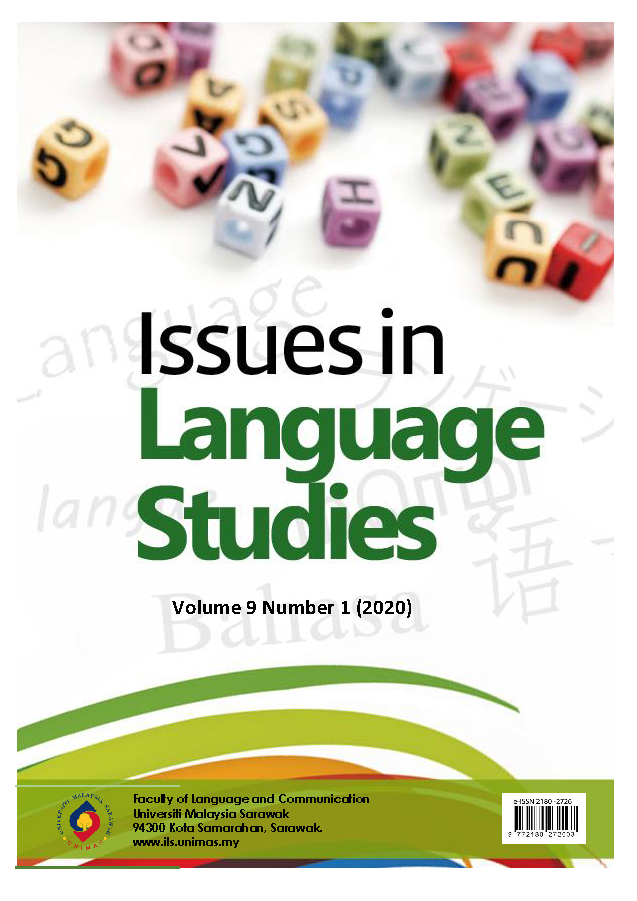Abstract
Kajian ini meneliti aspek kesantunan bahasa dalam masyarakat Melayu Sarawak dan Iban di daerah Kuching dan Samarahan, khususnya dalam penggunaan bahasa halus atau eufemisme. Objektif khusus kajian adalah untuk meneliti bentuk eufemisme yang wujud dan digunakan dalam masyarakat Melayu Sarawak dan Iban, dan juga melihat sejauh mana eufemisme tersebut digunakan dalam kedua-dua masyarakat tersebut. Data kajian diperoleh menerusi kaedah soal selidik, melibatkan responden seramai 50 orang bagi setiap kaum. Soalan dirangka mengikut beberapa domain daripada pengkategorian eufemisme oleh Allan dan Burridge (1991), iaitu hal kewanitaan dan kelelakian, kemarahan/makian/kebencian, penyakit, kematian, dan ketakutan berunsurkan haiwan serta makhluk halus. Dapatan kajian menunjukkan penggunaan bahasa halus secara sederhana adalah tinggi, iaitu bagi golongan penutur berusia 40 tahun ke bawah, melibatkan kedua-dua masyarakat. Penutur juga didapati memahami perkataan dan ujaran bahasa halus walaupun ia tidak bersifat langsung. Kajian ini juga dapat memperjelas bentuk bahasa halus yang wujud dan tahap penggunaannya dalam masyarakat Melayu Sarawak dan Iban, selain memaparkan latar budaya masyarakat penutur yang kaya dengan kehalusan bahasanya.
References
Affidah Morni, Aiza Johari, Johny Ahmad, & Kamaruzaman Jusoff. (2009). The linguistic taboo between Malays and Ibans of Sarawak, Malaysia. Canadian Social Science, 5(3), 141-158.
Allan, K., & Burridge, K. (1991). Euphemism & dysphemism: Language used as shield and weapon. Oxford: Oxford University Press.
Asmah Haji Omar. (2008). Ensiklopedia Bahasa Melayu. Kuala Lumpur, Malaysia: Dewan Bahasa dan Pustaka.
Hamidah Abdul Wahab, Imran Ho Abdullah, Mohammed Azlan Mis, & Khazriyati Salehuddin. (2016). Analisis eufemisme kematian masyarakat Melayu Sarawak dari perspektif Semantik Kognitif. GEMA Online® Journal of Language Studies, 16(2), 53-71.
https://doi.org/10.17576/gema-2016-1602-04
Jamet, D. (2018). The noelogical functions of disease euphemisms in English and French: Verbal hygiene or speech pathology? Journal in English Lexicology, 12, 1-26.
https://doi.org/10.4000/lexis.2397
Mohammed Azlan Mis. (2010). Lingua franca suku kaum di Sarawak. Jurnal Bahasa, 20, 131-151.
Mohammed Azlan Mis. (2012). Medium perantara pelbagai suku kaum di Sarawak: Kajian lingua franca. GEMA OnlineTM Journal of Language Studies, 12(3), 903-922.
Noriah Mohamed, & Jamilah Bebe Mohamad. (2016). Eufemisme leksikal dan metafora kematian dalam dialek Melayu Kedah. Journal of Education dan Social Sciences, 4, 331-342.
Rabab'ah, G., & Al-Qarni, AM. (2012). Euphemism in Saudi Arabic and English. Journal of Pragmatics, 44, 730-743.
https://doi.org/10.1016/j.pragma.2012.02.008
Radzi, H., & David, P. (2012). Unsur eufemisme dan perumpamaan dalam teks hikayat Iban. Jurnal Linguistik, 16, 75-87.
Ringit, C., Hamidah Abdul Wahab & Gedat, R. (2019). Domain kepercayaan bahasa halus masyarakat Iban Sebuyau, Sarawak: Analisis metafora konsepsi. Asian People Journal, 2(2), 18-30.
Copyright Transfer Statement for Journal
1) In signing this statement, the author(s) grant UNIMAS Publisher an exclusive license to publish their original research papers. The author(s) also grant UNIMAS Publisher permission to reproduce, recreate, translate, extract or summarize, and to distribute and display in any forms, formats, and media. The author(s) can reuse their papers in their future printed work without first requiring permission from UNIMAS Publisher, provided that the author(s) acknowledge and reference publication in the Journal.
2) For open access articles, the author(s) agree that their articles published under UNIMAS Publisher are distributed under the terms of the CC-BY-NC-SA (Creative Commons Attribution-Non Commercial-Share Alike 4.0 International License) which permits unrestricted use, distribution, and reproduction in any medium, for non-commercial purposes, provided the original work of the author(s) is properly cited.
3) For subscription articles, the author(s) agree that UNIMAS Publisher holds copyright, or an exclusive license to publish. Readers or users may view, download, print, and copy the content, for academic purposes, subject to the following conditions of use: (a) any reuse of materials is subject to permission from UNIMAS Publisher; (b) archived materials may only be used for academic research; (c) archived materials may not be used for commercial purposes, which include but not limited to monetary compensation by means of sale, resale, license, transfer of copyright, loan, etc.; and (d) archived materials may not be re-published in any part, either in print or online.
4) The author(s) is/are responsible to ensure his or her or their submitted work is original and does not infringe any existing copyright, trademark, patent, statutory right, or propriety right of others. Corresponding author(s) has (have) obtained permission from all co-authors prior to submission to the journal. Upon submission of the manuscript, the author(s) agree that no similar work has been or will be submitted or published elsewhere in any language. If submitted manuscript includes materials from others, the authors have obtained the permission from the copyright owners.
5) In signing this statement, the author(s) declare(s) that the researches in which they have conducted are in compliance with the current laws of the respective country and UNIMAS Journal Publication Ethics Policy. Any experimentation or research involving human or the use of animal samples must obtain approval from Human or Animal Ethics Committee in their respective institutions. The author(s) agree and understand that UNIMAS Publisher is not responsible for any compensational claims or failure caused by the author(s) in fulfilling the above-mentioned requirements. The author(s) must accept the responsibility for releasing their materials upon request by Chief Editor or UNIMAS Publisher.
6) The author(s) should have participated sufficiently in the work and ensured the appropriateness of the content of the article. The author(s) should also agree that he or she has no commercial attachments (e.g. patent or license arrangement, equity interest, consultancies, etc.) that might pose any conflict of interest with the submitted manuscript. The author(s) also agree to make any relevant materials and data available upon request by the editor or UNIMAS Publisher.

